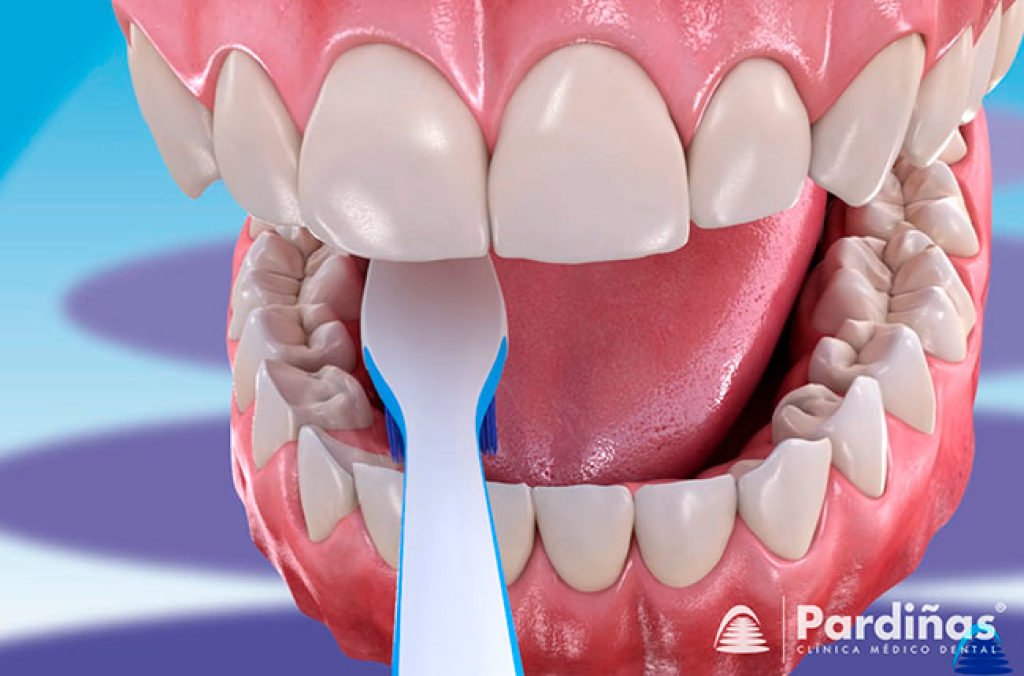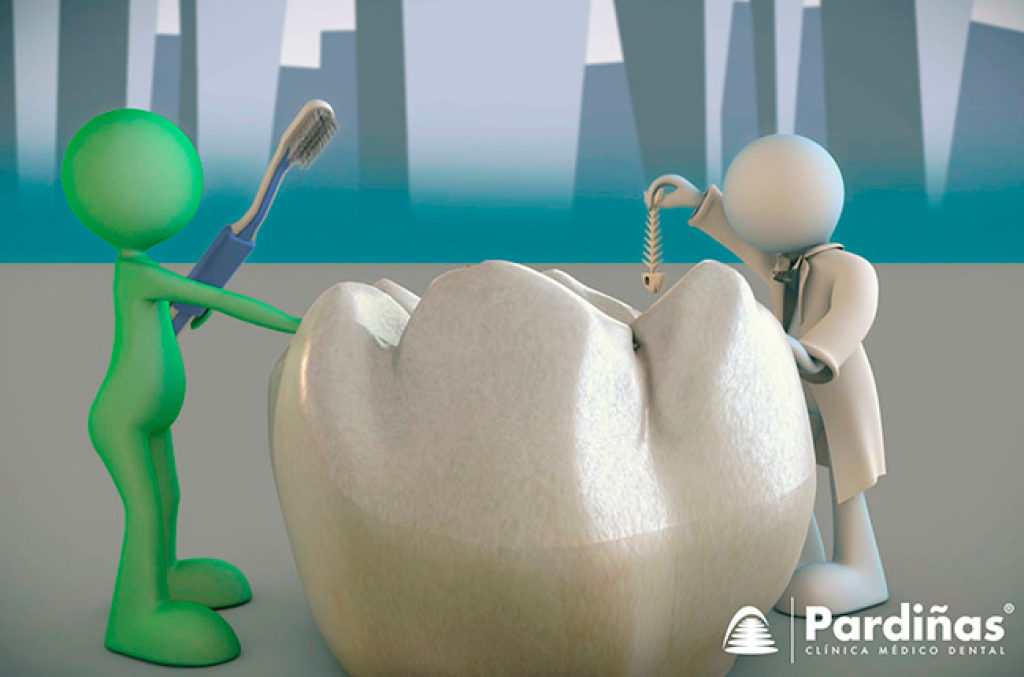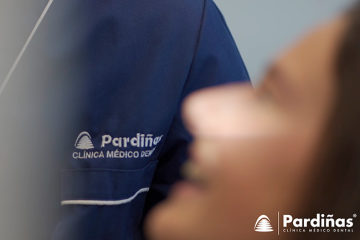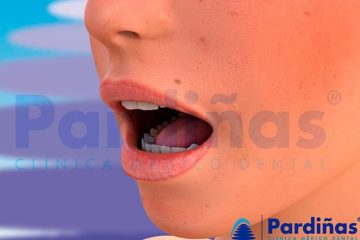It is known as dental prophylaxis or teeth cleaning to the treatment carried out by the dentist or hygienist to eliminate tartar and bacterial plaque deposits around a patient's teeth. Here we tell you everything about this procedure.
- 1) What is a deep dental cleaning?
- 2) What are the goals of a dental cleaning?
- 3) How is it performed?
- 4) Does it hurt to receive a professional dental cleaning?
- 5) Can prophylaxis be performed in patients with veneers, crowns and/or fillings?
- 6) Differences between dental cleaning, scaling and root planing and curettage
-
7) Is oral cleaning the same as teeth whitening?
1) What is a deep dental cleaning?
A professional mouth cleaning is a treatment that serves to remove most of the bacterial plaque and tartar that accumulate on the teeth and around and under the gums.
1A) What is dental plaque?
Dental plaque is that yellowish-white substance that is deposited on the teeth and gums when we do not brush correctly. It has a soft consistency and is made up of the combination of saliva with food remains, dead cells and bacteria. It can be easily removed with brushing, flossing, interdental brushes, and irrigators because it is a soft substance.

1B) What is dental tartar?
Dental tartar is the substance that appears when plaque is not removed on time and ends up calcifying. It is not possible to remove it with a toothbrush or complementary means because the tartar is already hard and firmly adhered to the tooth. Only a professional dental cleaning is capable of removing this substance.

2) What are the goals of a dental cleaning?
Bacterial plaque and dental tartar are responsible for two major oral health problems: periodontal disease and cavities. For this reason, this cleaning is also known as dental prophylaxis, since its main objective is to prevent these diseases.
2A) Prevent the appearance of cavities
Scaling can prevent the development of caries. If a cavity goes deep into the tooth, it may be necessary to do a root canal or even an extraction if the piece is badly damaged.

2B) Avoid the development of periodontal disease
Periodontitis is a great unknown despite being the leading cause of tooth loss in adults. This periodontal disease is caused by bacteria that are deposited in the plaque and tartar and that in their metabolism destroy the bone and the periodontal ligament until the loss of the teeth. It is therefore a chronic infectious disease. It is true that not everyone with plaque and tartar will develop periodontal disease, but a genetic predisposition is necessary. Our job is to detect this problem in the early stages to try to stop or stabilize its progression since it does not usually cause discomfort until very advanced stages. Some common symptoms are bleeding, bad breath, and loose teeth.

3) How is it performed?
Professional oral cleaning is carried out with an ultrasonic device whose vibration causes the tartar to be detached from the surface of the tooth without scratching the enamel. Although this ultrasonic vibration can be somewhat annoying, it does not damage the tooth. The curette is also used during prophylaxis, an instrument that serves to scrape and smooth the root of the tooth. Finally, it is usually complemented with the use of mechanical brushes with polishing pastes and/or the use of bicarbonate to remove surface stains.
3A) Who performs teeth cleanings?
The professional in charge of performing the scaling is the dental hygienist. This professional also motivates and instructs the patient in oral hygiene techniques, supervises them, and performs the basic procedures of periodontal treatments.

3B) How often is it recommended to have a dental cleaning?
It depends on each case. It is usually done once a year under normal conditions, although there are patients who barely make tartar and have very good hygiene who hardly need prophylaxis. On the contrary, if we detect that a patient begins to develop periodontitis, it may be necessary to do it every six months. It is also recommended that patients with dental implants carry out a cleaning at least every 6 months. At the other extreme are those who are very susceptible to suffering from the disease and which also progresses rapidly, in which case it may be necessary to do maintenance every two or three months.

3C) Is it bad for the teeth?
Absolutely not. The number of necessary prophylaxis depends on the severity of the periodontal problem, becoming recommended every two or three months in some patients. However, when used properly, ultrasound does not wear down teeth. There is a myth that says that removing tartar causes teeth to move. If this happens, it means that the bone loss around the roots is very advanced and that the tartar has created a false support between the teeth. Obviously, greater mobility will be noticed if it is removed, but the fact is that the foundations were already lost due to the infectious process.

4) Does it hurt to receive a professional dental cleaning?
Mouth cleanings DO NOT hurt although the vibrations can be somewhat uncomfortable. It can generate some discomfort in those patients who have dental sensitivity, but it is possible to place local anesthesia so that the patient does not notice anything.
4A) Is anesthesia necessary to perform it?
It is NOT necessary to numb someone who is going to receive prophylaxis under normal conditions. However, the use of infiltrative anesthesia or topical anesthesia may be necessary to “sleep” the superficial gingiva and increase the comfort of patients with hypersensitivity. Infiltrative anesthesia is also used in those patients who have a great inflammation of the gums and deep tartar. However, it is up to the professional to make the diagnosis in each case.

4B) Does periodontal prophylaxis cause sensitivity?
The use of ultrasonic devices on the teeth produces a vibration that can be somewhat unpleasant. This sensitivity can be temporarily increased in patients who already have thermal changes. For these cases, the water used for ultrasonic cooling is warm, thus minimizing hypersensitivity. Ultrasonic devices need water cooling to avoid transmitting excessive heat to the tooth. In some situations, after the removal of tartar, there may be a slight sensitivity that usually decreases until it disappears after a few days. For these cases, the professional will recommend a desensitizing mouthwash, to be used several times a day for a while. In other cases, fluoride is applied after performing the prophylaxis to mitigate subsequent sensitivities.
5) Can prophylaxis be performed in patients with veneers, crowns and/or fillings?
Of course. The hygienist will carefully treat those margins between the restorative material, tooth and gum. If ultrasound devices are used improperly, we can scratch the restorations and even detach them.
5A) How is cleaning done in patients with implants?
Just as teeth can suffer from periodontitis, implants can develop peri-implantitis due to germs that accumulate in plaque and tartar around and under the implants. Therefore, scaling helps both to prevent periodontal disease and any complications with implants. However, different particularities are required in patients with implants when performing cleaning. It is essential to be careful not to scratch the surface, for which special Teflon tips are used. To clean below the pontic area, a special dental floss is used. Likewise, the use of the irrigator is recommended in the daily hygiene of this type of patients. Nowadays, most of the prosthesis that are placed on the implants are usually screwed. In these cases, it is relatively easy to remove the prostheses in order to better clean the contour of the implants when necessary.

6) Differences between dental cleaning, scaling and root planing and curettage
It is important to be clear about the difference between a "common" dental prophylaxis and other types of cleanings. In short, we can say that teeth cleaning is done in a mouth without active periodontal disease and scaling and curettage when there is already periodontitis. In some cases, common prophylaxis can also be performed in a mouth treated for periodontitis as maintenance to prevent the progression of the disease.
6A) The phases of periodontal disease
Periodontitis goes through different stages: it usually starts with gingivitis, which is an inflammation of the gum but without affecting the underlying tissues. The main cause is the germs that are inside the dental plaque and the accumulated tartar. There are other causes of gingivitis such as pregnancy or some related to various health problems or the consumption of certain types of medications. Untreated gingivitis can evolve into periodontitis, in which the deep tissues surrounding the root, such as the periodontal ligament and bone, are already beginning to be affected. The severity of periodontitis depends on its stage and its treatment will depend on it.

6B) Scaling and root planing, two treatments for periodontal disease
When there is incipient or moderate periodontitis, prophylaxis is combined with scaling and root planing, which is performed with instruments called curettes. These have sharp edges to be able to remove the deep tartar attached to the roots of the teeth and smooth them to delay the new deposit of tartar at that level. The curettage is carried out together with the scraping, which is nothing more than the elimination of the inflamed part of the periodontal pocket.
7) Is oral cleaning the same as teeth whitening?
Do not confuse mouth cleaning with teeth whitening. The goal of prophylaxis is the removal of plaque and tartar that are above and below the gums. In the same process, they will also try to eliminate unsightly stains caused by stains from coffee, tea, tobacco, red wine, certain types of mouthwashes, etc. However, in no case will the intrinsic color of the tooth be changed. For its part, the objective of whitening is to return the tooth to its natural color. For this, products are used that, applied to the enamel, release oxygen. These must penetrate and reach the dentin, which is actually what gives the tooth its color. So it's a totally different procedure. In addition, the mouth must be healthy to be able to do teeth whitening.


